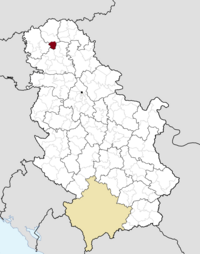Mali Iđoš
Mali Iđoš
Мали Иђош Kishegyes | |
|---|---|
Village | |
 Church of Saint Anne in Mali Iđoš | |
 Location of the municipality of Mali Iđoš within Serbia | |
| Country | |
| District | North Bačka |
| Settlements | 3 |
| Government | |
| • Mayor | Csóré Róbert |
| Area | |
| • Municipality | 175 km2 (68 sq mi) |
| Population (2011 census)[2] | |
| • Town | 4,830 |
| • Municipality | 11,926 |
| Time zone | UTC+1 (CET) |
| • Summer (DST) | UTC+2 (CEST) |
| Postal code | 24321 |
| Area code | +381 24 |
| Car plates | SU |


Mali Iđoš (Serbian and Montenegrin Cyrillic: Мали Иђош, pronounced [mâːliː îdʑoʃ]; Hungarian: Kishegyes, pronounced [ˈkiʃhɛɟɛʃ]) is a village and municipality in the North Bačka District of Vojvodina, Serbia. The municipality comprises three local communities and has a population of 12,031, of whom 6,486 (53.91%) are ethnic Hungarians, 2,388 are Serbs (19.85%) and 1,956 are Montenegrins (16.26%). Mali Iđoš village has a population of 4,830.
Name
The first part of the name of the village, "mali" ("little" in English), was given in contrast to the village with similar name (Iđoš), which is situated in northern Banat.
Inhabited places
Mali Iđoš municipality includes the following villages:
- Mali Iđoš (Hungarian: Kishegyes)
- Lovćenac (Montenegrin: Lovćenac / Ловћенац)
- Feketić (Hungarian: Bácsfeketehegy)
Demographics
According to the 2011 census, the total population of the Mali Iđoš municipality is 12,031. By ethnic structure:[3]
- 6,486 Hungarians (53.91%)
- 2,388 Serbs (19.85%)
- 1,956 Montenegrins (16.26%)
- 283 Romani (2.35%)
- 55 Croats (0.46%)
- 43 Albanians (0.36%)
- 33 Ethnic Muslims (0.27%)
- 30 Rusyns (0.25%)
- 24 Yugoslavs (0.2%)
- 20 Macedonians (0.17%)
- 15 Ukrainians (0.12%)
- 13 Bunyevs (0.11%)
- 13 Germans (0.11%)
- 8 Slovenes (0.07%)
- 8 Russians (0.07%)
- 4 Slovaks (0.03%)
- 3 Bosniaks (0.02%)
- 2 Romanians (0.02%)
- others - 123 (1.02%)
- non-declared - 371 (3.08%)
- regionally declared - 64 (0.53%)
- unknown - 85 (0.71%)
By language:
- 6,683 Hungarian (55.55%)
- 4,470 Serbian (37.15%)
- 270 Montenegrin (2.24%)
- 24 Croatian (0.2%)
- 16 Rusyn (0.13%)
- 3 Romanian (0.02%')
- 2 Slovak (0.02%)
- 337 other (2.8%)
- 137 undeclared (1.14%)
- 89 unknown (0.74%)
By religion:
- 10,862 Christians (90.28%)
- 4,478 Catholics (37.22%)
- 4,257 Eastern Orthodox Christians (35.38%)
- 2,086 Protestants (17.34%)
- 18 other (0.15%)
- 232 Muslims (1.93%)
- 10 other (0.08%)
- 181 atheist (1.5%)
- 604 undeclared (5.02%)
- 142 unknown (1.18%)
Local communities with a Hungarian majority are Mali Iđoš and Feketić. There is one local community with a Montenegrin majority: Lovćenac.
History
The name of Kishegyes was first mentioned in historical documents in 1476. The village became totally destroyed under Turkish occupation in the 16th century. It was repopulated in 1769 by 81 Roman Catholic Hungarian families from Békésszentandrás. The region is extremely well suited for agriculture and the village increased in wealth and population until the 1980s. In the 1990s the local economy was ruined and young people began to emigrate to Hungary. Today the rate of unemployment is appr. 30 percent, and the Agricultural Cooperative and the Commercial Company went bankrupt. After the end of the civil war in Croatia and Bosnia (1995–96) Serbian refugees arrived to Mali Iđoš (Kishegyes). There are no ethnic tensions between native Hungarians and the Serbian refugees.
Historical population of the village
- 1961: 6,860
- 1971: 6,603
- 1981: 6,271
- 1991: 5,803
- 2002: 5,464
- 2011: 4,830
Sights
The oldest building in Mali Iđoš is the baroque Roman Catholic Church of St. Anne (1788) on the Main Street. There is an old Calvary, the obelisk of the Battle of Kishegyes and the ruins of the Pecze Mansion. The natural attractions are the River Krivaja and the imposing loessal walls of the Hills of Telečka.
Famous people
- The Hungarian singer Magdolna Rúzsa grew up in Mali Iđoš. She won Megasztár, Hungary's version of Pop Idol in 2006 and represented Hungary at the Eurovision Song Contest 2007 in Helsinki, Finland.
- Istvan Dudas is a former Serbian professional footballer, who currently works as Goalkeeper coach for R.O.C. de Charleroi-Marchienne.[4]
International relations
Twin towns – Sister cities
Mali Iđoš is twinned with:
 Cetinje, Montenegro, since 2012
Cetinje, Montenegro, since 2012
See also
- List of Hungarian communities in Vojvodina
- List of places in Serbia
- List of cities, towns and villages in Vojvodina
References
- ^ "Municipalities of Serbia, 2006". Statistical Office of Serbia. Retrieved 2010-11-28.
- ^ "2011 Census of Population, Households and Dwellings in the Republic of Serbia: Comparative Overview of the Number of Population in 1948, 1953, 1961, 1971, 1981, 1991, 2002 and 2011, Data by settlements" (PDF). Statistical Office of Republic Of Serbia, Belgrade. 2014. ISBN 978-86-6161-109-4. Retrieved 2014-06-27.
- ^ "Population by ethnicity – Mali Iđoš". Statistical Office of the Republic of Serbia (SORS). Retrieved 28 February 2013.
- ^ Le Noyau : Istvan Dudas (T3) - ROCCM
- Slobodan Ćurčić, Broj stanovnika Vojvodine, Novi Sad, 1996.





